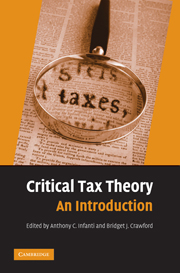Book contents
- Frontmatter
- Contents
- List of Illustrations
- List of Tables
- List of Contributors
- List of Common Abbreviations
- Introduction
- CHAPTER 1 FOUNDATIONS OF CRITICAL TAX THEORY
- CHAPTER 2 HISTORICAL PERSPECTIVES ON TAXATION
- CHAPTER 3 THE GOALS OF TAX POLICY
- CHAPTER 4 CRITICAL TAX THEORY MEETS PRACTICE
- CHAPTER 5 RACE AND TAXATION
- CHAPTER 6 GENDER AND TAXATION
- CHAPTER 7 SEXUAL ORIENTATION AND TAXATION
- CHAPTER 8 THE FAMILY AND TAXATION
- Love, Money, and the IRS: Family, Income-Sharing, and the Joint Income Tax Return
- Innocent Spouses: A Critique of the New Tax Laws Governing Joint and Several Tax Liability
- Taxation and the Family: A Fresh Look at Behavioral Gender Biases in the Code
- The Profits and Penalties of Kinship: Conflicting Meanings of Family in Estate Tax Law
- The Tax Treatment of Children: Separate but Unequal
- Rocking the Tax Code: A Case Study of Employment-Related Child-Care Expenditures
- CHAPTER 9 CLASS AND TAXATION
- CHAPTER 10 DISABILITY AND TAXATION
- CHAPTER 11 GLOBAL CRITICAL PERSPECTIVES ON TAXATION
- CHAPTER 12 CRITICAL PERSPECTIVES ON CRITICAL TAX THEORY
- Index
The Tax Treatment of Children: Separate but Unequal
Published online by Cambridge University Press: 04 August 2010
- Frontmatter
- Contents
- List of Illustrations
- List of Tables
- List of Contributors
- List of Common Abbreviations
- Introduction
- CHAPTER 1 FOUNDATIONS OF CRITICAL TAX THEORY
- CHAPTER 2 HISTORICAL PERSPECTIVES ON TAXATION
- CHAPTER 3 THE GOALS OF TAX POLICY
- CHAPTER 4 CRITICAL TAX THEORY MEETS PRACTICE
- CHAPTER 5 RACE AND TAXATION
- CHAPTER 6 GENDER AND TAXATION
- CHAPTER 7 SEXUAL ORIENTATION AND TAXATION
- CHAPTER 8 THE FAMILY AND TAXATION
- Love, Money, and the IRS: Family, Income-Sharing, and the Joint Income Tax Return
- Innocent Spouses: A Critique of the New Tax Laws Governing Joint and Several Tax Liability
- Taxation and the Family: A Fresh Look at Behavioral Gender Biases in the Code
- The Profits and Penalties of Kinship: Conflicting Meanings of Family in Estate Tax Law
- The Tax Treatment of Children: Separate but Unequal
- Rocking the Tax Code: A Case Study of Employment-Related Child-Care Expenditures
- CHAPTER 9 CLASS AND TAXATION
- CHAPTER 10 DISABILITY AND TAXATION
- CHAPTER 11 GLOBAL CRITICAL PERSPECTIVES ON TAXATION
- CHAPTER 12 CRITICAL PERSPECTIVES ON CRITICAL TAX THEORY
- Index
Summary
This article considers the question of why the Code has two separate provisions that affect children, namely the earned income tax credit (EITC) and the child tax credit (CTC). They are separate but serve similar purposes, and they are unequal because CTC families receive far greater tax benefits than EITC families. This article seeks to uncover why there is a need for two tax credits which benefit children differently and concludes that the only plausible explanation is related to race.
EARNED INCOME TAX CREDIT
The primary requirement of the EITC is that it only applies to “earned income.” It provides a refundable credit for the working poor, which means low-income taxpayers may receive a refund in excess of their income tax withholding and, in certain instances, in excess of their Social Security withholding. In many instances, EITC-eligible families would live below the poverty line without the EITC refund.
As originally enacted, the EITC did not increase for family size. Subsequent amendments now allow the EITC to increase both for family and low-income wage earners without children. Married couples must file joint returns.
The EITC creates marriage bonuses and marriage penalties in certain households. Marriage bonuses occur when the spouses pay less in taxes (or receive a greater refund) as a result of marriage. Marriage penalties occur when the spouses pay more in taxes (or receive a smaller refund) as a result of marriage. In 2001, the EITC was amended to minimize the marriage penalty paid by EITC-eligible taxpayers.
- Type
- Chapter
- Information
- Critical Tax TheoryAn Introduction, pp. 254 - 260Publisher: Cambridge University PressPrint publication year: 2009



